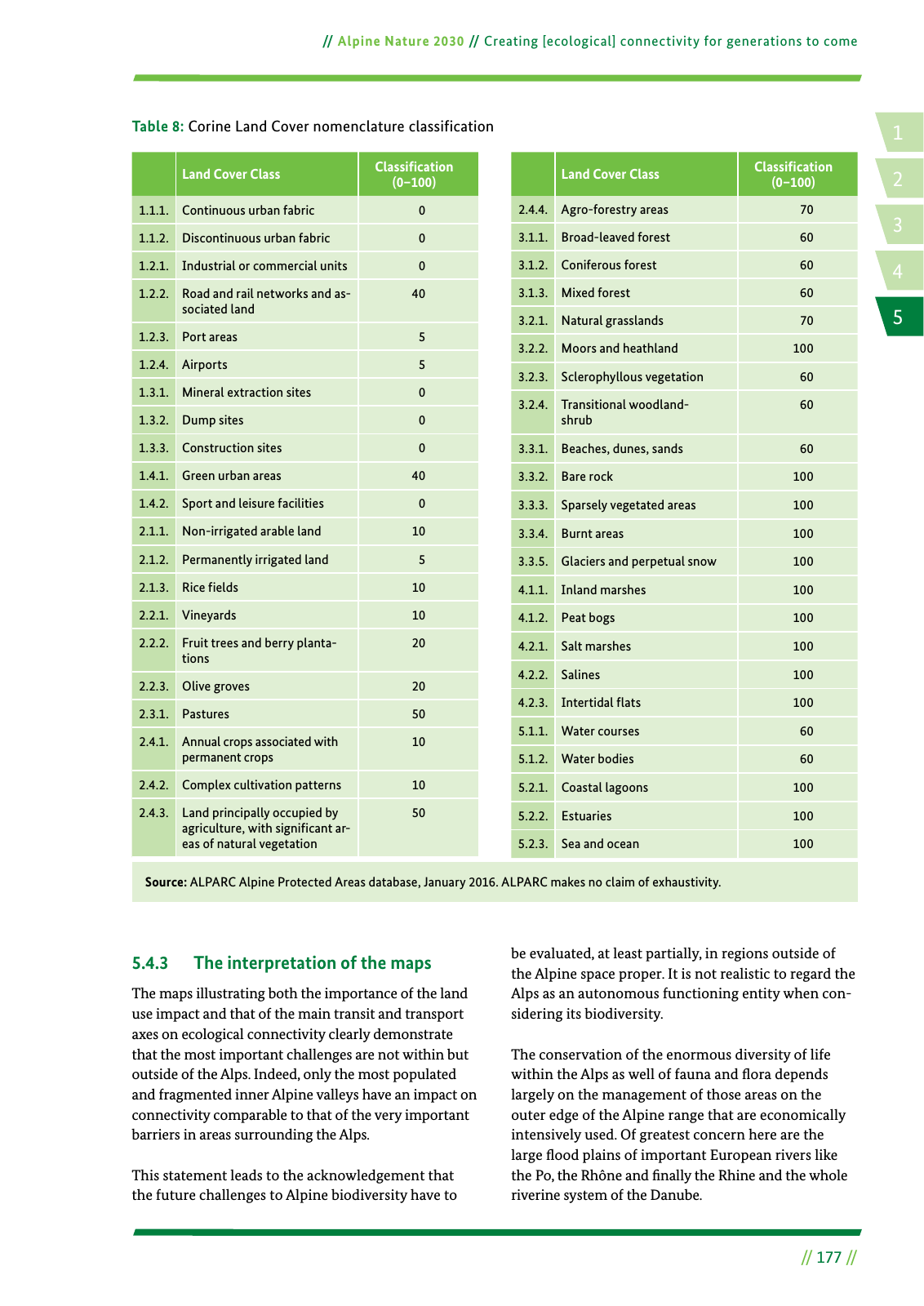14 2 5 3 Alpine Nature 2030 Creating ecological connectivity for generations to come 177 Land Cover Class Classiªcation 0 100 1 1 1 Continuous urban fabric 0 1 1 2 Discontinuous urban fabric 0 1 2 1 Industrial or commercial units 0 1 2 2 Road and rail networks and as sociated land 40 1 2 3 Port areas 5 1 2 4 Airports 5 1 3 1 Mineral extraction sites 0 1 3 2 Dump sites 0 1 3 3 Construction sites 0 1 4 1 Green urban areas 40 1 4 2 Sport and leisure facilities 0 2 1 1 Non irrigated arable land 10 2 1 2 Permanently irrigated land 5 2 1 3 Rice fields 10 2 2 1 Vineyards 10 2 2 2 Fruit trees and berry planta tions 20 2 2 3 Olive groves 20 2 3 1 Pastures 50 2 4 1 Annual crops associated with permanent crops 10 2 4 2 Complex cultivation patterns 10 2 4 3 Land principally occupied by agriculture with significant ar eas of natural vegetation 50 2 4 4 Agro forestry areas 70 3 1 1 Broad leaved forest 60 3 1 2 Coniferous forest 60 3 1 3 Mixed forest 60 3 2 1 Natural grasslands 70 3 2 2 Moors and heathland 100 3 2 3 Sclerophyllous vegetation 60 3 2 4 Transitional woodland shrub 60 3 3 1 Beaches dunes sands 60 3 3 2 Bare rock 100 3 3 3 Sparsely vegetated areas 100 3 3 4 Burnt areas 100 3 3 5 Glaciers and perpetual snow 100 4 1 1 Inland marshes 100 4 1 2 Peat bogs 100 4 2 1 Salt marshes 100 4 2 2 Salines 100 4 2 3 Intertidal flats 100 5 1 1 Water courses 60 5 1 2 Water bodies 60 5 2 1 Coastal lagoons 100 5 2 2 Estuaries 100 5 2 3 Sea and ocean 100 Land Cover Class Classiªcation 0 100 5 4 3 The interpretation of the maps The maps illustrating both the importance of the land use impact and that of the main transit and transport axes on ecological connectivity clearly demonstrate that the most important challenges are not within but outside of the Alps Indeed only the most populated and fragmented inner Alpine valleys have an impact on connectivity comparable to that of the very important barriers in areas surrounding the Alps This statement leads to the acknowledgement that the future challenges to Alpine biodiversity have to be evaluated at least partially in regions outside of the Alpine space proper It is not realistic to regard the Alps as an autonomous functioning entity when con sidering its biodiversity The conservation of the enormous diversity of life within the Alps as well of fauna and ora depends largely on the management of those areas on the outer edge of the Alpine range that are economically intensively used Of greatest concern here are the large ood plains of important European rivers like the Po the Rhône and nally the Rhine and the whole riverine system of the Danube Table 8 Corine Land Cover nomenclature classification Source ALPARC Alpine Protected Areas database January 2016 ALPARC makes no claim of exhaustivity

Hinweis: Dies ist eine maschinenlesbare No-Flash Ansicht.
Klicken Sie hier um zur Online-Version zu gelangen.
Klicken Sie hier um zur Online-Version zu gelangen.